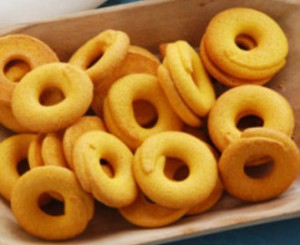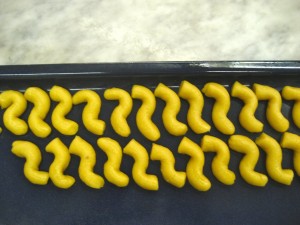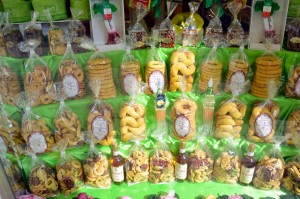I bussolai buranei, da biscotti dei pescatori a dolci di Pasqua di VeneziaThe bussolai buranei, from fishermen cookies to cakes in Venice Easter
Nati per accompagnare i viaggi in mare, hanno fatto la fortuna dei pasticceri di Burano, cambiando anche forma per essere più agevoli da inzuppare
Bussolai è il nome con sui sono più conosciuti, bussolà la pronuncia in dialetto locale e buranelli il modo alternativo di chiamarli. Sono gli storici biscotti della tradizione veneziana, fatti con i tuorli d’uovo, la farina e una quantità industriale di burro. Si trovano in due varianti: rotondi o a forma di “esse” e sono considerati una specialità locale: la loro origine, però, risale a parecchi secoli fa, ai tempi della Repubblica di Venezia.
Il cerchio della storia.
I primi bussolai erano quelli tondi, a forma di ciambella,  come conferma il loro nome, visto che “busa” in dialetto veneziano vuol dire proprio “buco”. Secondo quanto riportano le antiche leggende, questi biscotti venivano preparati in casa dalle mogli dei pescatori e dei marinai in grandi quantità: quando i mariti partivano per mare, ne portavano con sé diversi sacchi, perché erano molto nutrienti e soprattutto si conservavano bene, indurendosi appena con il passare del tempo. L’usanza divenne così diffusa che tra le case colorate dell’isola di Burano, qualcuno cominciò a produrli su larga scala e a venderli. Da gallette dei marinai nelle lunghe traversate, i bussolai divennero presto un dolce consumato soprattutto nel periodo pasquale da tutti gli abitanti di Venezia. Nessuno escluso, visto che, si racconta, nel XVI secolo le Suore del Convento di San Maffio ricevettero l’ordine di ridurre le spese per l’acquisto dei Bussolai poiché ne consumavano fin troppi. Troppo difficile resistere, visto che il loro convento si trovava nell’isoletta di Mazzorbo, collegata da un ponte a quella di Burano, dove si concentrava al produzione di questi biscotti, che aromatizzati alla vaniglia venivano usati anche per profumare i cassetti della biancheria.
come conferma il loro nome, visto che “busa” in dialetto veneziano vuol dire proprio “buco”. Secondo quanto riportano le antiche leggende, questi biscotti venivano preparati in casa dalle mogli dei pescatori e dei marinai in grandi quantità: quando i mariti partivano per mare, ne portavano con sé diversi sacchi, perché erano molto nutrienti e soprattutto si conservavano bene, indurendosi appena con il passare del tempo. L’usanza divenne così diffusa che tra le case colorate dell’isola di Burano, qualcuno cominciò a produrli su larga scala e a venderli. Da gallette dei marinai nelle lunghe traversate, i bussolai divennero presto un dolce consumato soprattutto nel periodo pasquale da tutti gli abitanti di Venezia. Nessuno escluso, visto che, si racconta, nel XVI secolo le Suore del Convento di San Maffio ricevettero l’ordine di ridurre le spese per l’acquisto dei Bussolai poiché ne consumavano fin troppi. Troppo difficile resistere, visto che il loro convento si trovava nell’isoletta di Mazzorbo, collegata da un ponte a quella di Burano, dove si concentrava al produzione di questi biscotti, che aromatizzati alla vaniglia venivano usati anche per profumare i cassetti della biancheria.
I bussolai al giorno d’oggi.
 Qualche secolo più tardi, un famoso ristoratore di Burano chiese ad un fornaio locale di preparargli un bussolaio da offrire ai propri clienti come dessert, magari accompagnato da un bicchiere di vino dolce. Il pasticcere ci pensò a lungo e diede vita a un nuovo biscotto, con lo stesso impasto, ma con una forma a “esse” che permetteva di inzupparlo comodamente, garantendogli così ampia fortuna anche a colazione con il latte. Al giorno d’oggi i bussolai si mangiano indistintamente in tutti i periodi dell’anno, anche se la tradizione pasquale sopravvive molto forte a Burano. È abitudine delle signore dell’isola infatti, durante la Settimana Santa, andare dai fornai per farsi cuocere l’impasto dei biscotti che offriranno ai loro ospiti la domenica.
Qualche secolo più tardi, un famoso ristoratore di Burano chiese ad un fornaio locale di preparargli un bussolaio da offrire ai propri clienti come dessert, magari accompagnato da un bicchiere di vino dolce. Il pasticcere ci pensò a lungo e diede vita a un nuovo biscotto, con lo stesso impasto, ma con una forma a “esse” che permetteva di inzupparlo comodamente, garantendogli così ampia fortuna anche a colazione con il latte. Al giorno d’oggi i bussolai si mangiano indistintamente in tutti i periodi dell’anno, anche se la tradizione pasquale sopravvive molto forte a Burano. È abitudine delle signore dell’isola infatti, durante la Settimana Santa, andare dai fornai per farsi cuocere l’impasto dei biscotti che offriranno ai loro ospiti la domenica.
Il fiore all’occhiello della pasticceria veneta.
Tra i dolci della tradizione veneta, i bussolai sono insieme alle fritole e al pan del Doge i più puri, quelli cioè, che non devono la propria nascita a “contaminazioni” culinarie avvenute in tempi remoti. La nobile arte della pasticceria era particolarmente apprezzata nella Repubblica di Venezia, tanto che nel 1493 nacque la corporazione degli Scaleteri, così chiamati dalle “scalete”, ciambelle dolci tipiche dei banchetti nuziali. Grazie ai possedimenti d’oltremare della Serenissima e ai numerosi viaggi in Oriente dei suoi commercianti, i pasticceri veneziani entrarono presto a contatto con le tradizioni dolciarie straniere. L’influenza ebraica si è fatta sentire sui dolci a base di mandorle come le impade o quelli a base di uvetta, come gli zaeti, mentre sotto la dominazione austriaca fu il cioccolato ad invadere la laguna.
Ingredienti
250 g di farina
80 g di zucchero
100 g di burro
3 tuorli
la scorza grattugiata di un limone
aroma di vaniglia
Procedimento
Mescolate i tuorli con il burro fuso e lasciato raffreddare, lavorate a lungo, poi unite la farina setacciata.
Profumate l’impasto con la scorza grattugiata di un limone e la vaniglia.
Preparate la classica palla di pasta e fate riposare in frigo per 20 minuti circa.
Prelevate dei pezzetti di pasta e formare delle “esse” e delle ciambelle: l’impasto è sufficiente per 40 biscotti.
Distribuite i biscotti su una teglia coperta di carta da forno.
Cuocete in forno caldo a 170°C per 15 minuti.
Sfornate a lasciate raffreddare su una gratella.
Conservate i biscotti in una scatola di latta ben chiusa.Born to accompany the trips at sea they have made the fortune of the confectioners of Burano, also changing the form to be easier to dip.
Bussolai is the name by which they are best known, bussolà the pronunciation in the local dialect and buranelli the alternative way to call them. Are the historical biscuits of Venetian tradition, made with egg yolks, flour and industrial quantities of butter. They are located in two variants: round or shaped “S” and are considered a local specialty: their origin, however, dates back several centuries ago, at the time of the Venetian Republic.
The circle of history.
The first bussolai were those round, donut-shaped,  as confirmed by their name, since “Busa” in Venetian dialect means precisely “hole.” Worldwide according to the ancient legends, these cookies were homemade and prepared by the wives of fishermen and sailors in large quantities when the husbands were leaving for the sea, they brought with them various bags, because they were very nutritious and above were kept well, just hardening little with the passage of time. The practice became so widespread that among the colorful houses of the island of Burano, someone began to produce them on a large scale and sell them. From biscuits of sailors on long voyages, the bussolai soon became a sweet consumed mainly during the Easter period by all the inhabitants of Venice. Without exception, because, it is said, in the sixteenth century, the Sisters of the Convent of San Maffio ordered to reduce expenses for the purchase of Bussolai because it consumed too many. Too hard to resist, given that their convent was located on the small island of Mazzorbo, connected by a bridge to that of Burano, where she concentrated on the production of these biscuits, flavored with vanilla that were also used to scent linen drawers.
as confirmed by their name, since “Busa” in Venetian dialect means precisely “hole.” Worldwide according to the ancient legends, these cookies were homemade and prepared by the wives of fishermen and sailors in large quantities when the husbands were leaving for the sea, they brought with them various bags, because they were very nutritious and above were kept well, just hardening little with the passage of time. The practice became so widespread that among the colorful houses of the island of Burano, someone began to produce them on a large scale and sell them. From biscuits of sailors on long voyages, the bussolai soon became a sweet consumed mainly during the Easter period by all the inhabitants of Venice. Without exception, because, it is said, in the sixteenth century, the Sisters of the Convent of San Maffio ordered to reduce expenses for the purchase of Bussolai because it consumed too many. Too hard to resist, given that their convent was located on the small island of Mazzorbo, connected by a bridge to that of Burano, where she concentrated on the production of these biscuits, flavored with vanilla that were also used to scent linen drawers.
The bussolai nowadays.
 A few centuries later, a famous Burano restaurateur asked to a local baker to prepare a bussolaio to offer to their customers as a dessert, perhaps accompanied by a glass of sweet wine. The confectioner thought long and gave us life in a new cookie, with the same dough, but with a form to “S” that allowed to soak comfortably, guaranteeing so wide luck even at breakfast with milk. Nowadays the bussolai you eat indiscriminately in all periods of the year, although the Easter tradition survives very strong in Burano. It is the habit of ladies island in fact, during Holy Week, go to the bakers to get bake cookie dough that offer their guests on Sunday.
A few centuries later, a famous Burano restaurateur asked to a local baker to prepare a bussolaio to offer to their customers as a dessert, perhaps accompanied by a glass of sweet wine. The confectioner thought long and gave us life in a new cookie, with the same dough, but with a form to “S” that allowed to soak comfortably, guaranteeing so wide luck even at breakfast with milk. Nowadays the bussolai you eat indiscriminately in all periods of the year, although the Easter tradition survives very strong in Burano. It is the habit of ladies island in fact, during Holy Week, go to the bakers to get bake cookie dough that offer their guests on Sunday.
The flagship of the Venetian pastry.
Among the desserts of the Venetian tradition, bussolai are together with the fritole and the pan del Doge the purest, that is, those who do not have their birth to culinary “contamination” occurred in ancient times. The noble art of pastry was particularly popular in the Venetian Republic, so much so that in 1493 was born the corporation of Scaleteri, so called from “scalete”, sweet donuts typical of the weddings. Thanks to the overseas territories of the Serenissima and the many trips to the East of its merchants, the Venetians confectioners came early in contact with foreign confectionery traditions. The Jewish influence has been felt on the sweet made with almonds as impade or those made from raisins, as zaeti while under Austrian domination was the chocolate to invade the lagoon.
Ingredients
250 g flour
80 g of sugar
100 g butter
3 egg yolks
the grated rind of one lemon
vanilla flavour
Method
Mix the egg yolks with the melted butter, beating for a long time, then add the sifted flour.
Scented the mixture with the grated rind of one lemon and vanilla.
Prepare the classic ball of dough and let rest in refrigerator for about 20 minutes.
Picked up the pieces of dough and roll into “S” and donuts: the dough is enough for 40 biscuits.
Spread the biscuits on a baking sheet covered with parchment paper.
Bake in preheated oven at 170 ° C for 15 minutes.
Remove from the oven to let it cool on a wire rack.
Keep the cookies in a tightly closed tin box.






Leave a comment